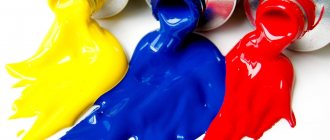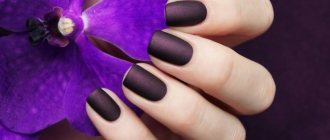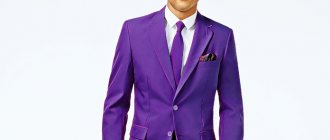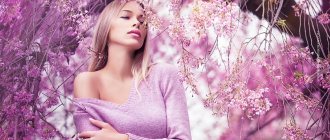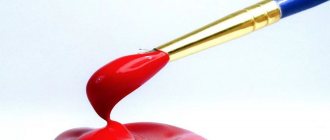What do you associate the color blue with? With a quiet and calm sea, a raging ocean, an endless and deep sky, and maybe with vast space, blue is the color of calm, confidence and comfort, it is deep and calm, reliable and discreet.
Since ancient times, blue has been considered the color of luxury, nobility and prosperity. This was believed due to the fact that for a long time blue paint was made from azure stone, which was very expensive. Accordingly, all things, jewelry, blue objects were very expensive, and only wealthy and wealthy people could afford them.
Origins
The famous Russian artist and theorist of fine arts, who stood at the origins of abstract art - Wassily Kandinsky - characterized the blue color as calm, typically heavenly, attracting to infinity, inspiring the desire for everything pure and supernatural.
Despite the familiarity of blue with its huge variety of shades, the history of this color is very tragic. It took her centuries and centuries to make humanity fall in love with “paint.” The history of the name of the color is also very interesting, because previously the word “blue” (as well as the adjectives “gray” and “gray”) did not mean a specific color, but only denoted the “degree of shine” of any other spectrum.
In Russian, as in the literature of other peoples, there are two main names for this part of the spectrum - blue and blue. In the context of semantic load, blue is considered as a variant of blue (in other words, blue is light blue). Therefore, both English definitions of our “little blue” and “little blue” correspond to the laconic American “blue”.
Rublevsky cabbage roll
The popularity of the mineral lapis lazuli was so great that its fame reached Rus'. In the 14th century, it experienced difficult times, being under the yoke of the Tatar yoke. However, even during this period, the construction of new churches did not stop, and new orders continued to be received by icon-painting artels.
This is how Andrei Rublev got the job, who was supposed to complete the decoration of the recently erected Trinity Cathedral. As a result, his most famous work appeared - the Trinity icon.
Everything in this work was new: both the interpretation of the plot and the unusually light coloring. To make the color relationship seem harmonious, Rublev abandoned the bright cinnabar (as, for example, in the earlier “Zyryan Trinity”), replacing it with soft pink and dark burgundy shades.
Zyryan Trinity, Stefan of Perm (?), 1379–1400. Source
The arrangement of color spots on the icon is subordinated to the compositional idea of a circle: Rublev paints the clothes of the angels with one blue pigment so that they reflect each other from opposite sides.
The paint that Rublev used, lapis lazuli, was incredibly expensive, and its use would not have been possible if it did not have important symbolic meaning. This blue-blue color, later called Rublevsky cabbage roll, resembled the heavenly light about which one of the church fathers, Isaac the Syrian, wrote: “A pure mind is likened to a heavenly color; during prayer, the light of the Holy Trinity shines in it.”
Trinity, Andrei Rublev, 1411 or 1425–1427. Source
Nature: uniqueness and rarity
Blue is one of the main three colors of the spectrum visible to humans. But in the natural conditions of flora and fauna there is very little of it. This happens because the biological pigment blue is not produced in the animal world (mammals, birds and insects). Natural sources of blue food are also negligible in the ecosystem.
However, there are pleasant exceptions: for example, the characteristic blue plumage of jays. Its uniqueness is achieved due to the frame made of a protein substance - keratin. Due to their complex structure, the feathers receive perfect aerodynamics and an intricate set of scales and hooks, which in tandem make up an exclusive optical system. This “design”, playing with black melanin and the aforementioned keratin, presents beautiful blue feathers to the human eye.
Another mysterious representatives of blue in nature are butterflies. One of the most beautiful representatives of these creatures is the blue Marfo with the brightest scales. But, again, the blue color is not due to the presence of the corresponding pigment. It is formed by an optical system with a complex geometric labyrinth.
Even modern advanced science does not give a clear answer to the question of why there is so little pure blue in natural conditions. Perhaps this color is unfavorable for the existence of flora and fauna due to the expanded perception of color by their representatives. For them, blue is too bright, so it is relevant only in habitats of specific predators. It simply interferes with most other living beings, because it eliminates any possibility of camouflage for further survival.
Blue: mild or alarming?
In everyday life of the 19th century, the fashion for blue subsided: it gave way to black. Men's formal suits, women's fashionable dresses, and student uniforms were black. But you will never see black in the paintings of the French impressionists, because the artists denied its existence in nature.
The Impressionists were among the first to notice that dark shadows are actually full of color - so in their bright canvases the shadows consist of cobalt blue, brown, synthetic ultramarine (similar to expensive lapis lazuli), emerald green, ocher yellow and red shades.
But the dominant color in the impressionist's palette was always blue. They used it not only to show the variety of shades in nature, but also to create a certain atmosphere.
Auguste Renoir preferred cobalt to convey the feeling of an elusive moment: the artist’s favorite model Marguerite Legrand would spin in a waltz like a blue haze, ride on a swing, and slip away into the infinity of time.
Swing, Auguste Renoir, 1876
Alas, the girl’s life was as fleeting as her image in the artist’s paintings was ephemeral: after creating “The Ball at the Moulin de la Galette,” Margarita fell ill with smallpox and soon died.
Ball at the Moulin de la Galette, Auguste Renoir, 1876. Source
Post-Impressionist Vincent Van Gogh was fascinated by the rich blue color, which helped him brighten his palette. As he reported to his brother in letters, surrounded by a cobalt sky, the stars seem like precious stones, and against the backdrop of the warm ultramarine sea, the shore becomes lilac and a little pale pink.
Boats with sand at the pier, Vincent Van Gogh, 1888. Source
In the painting “Starry Night,” painted in a hospital for the mentally ill, yellow seems to be in opposition to the contrasting blue color. Many researchers note that in this way the artist wanted to express the anxiety that he experienced on the eve of another attack of mental disorder.
Starry Night, Vincent Van Gogh, 1889 Source
Pigment: natural and synthetic
Throughout the centuries-old history of mankind, blue was one of the most sought after colors and was considered truly royal. He was deified and given special power, because getting pigment in those days was quite difficult. Blue was obtained after red, brown, black and even ocher were actively used, and were created only on the basis of natural components.
The ancient Egyptians first made blue. Europeans obtained it from a pastel herb (isatida). But the most popular pigment in the marine spectrum has become lapis lazuli, a metaphorical mineral and semi-precious stone. Its largest deposits are located on the territory of modern Afghanistan. Even in current conditions, geological developments are carried out using methods that were relevant several thousand years ago. It was on the basis of lapis lazuli that the ancient Egyptians made powder for their blue pigment. They decorated numerous temples and weapons, household appliances for the home and even jewelry.
At that time, the synthesis of pigment was a truly impressive achievement. To obtain the desired result, it was necessary to maintain a certain temperature level and the correct addition of oxygen.
Due to the excessive cost of lapis lazuli (about 4 times the cost of gold), the method of creating the pigment was gradually improved. In particular, crushed silica, lime, copper and an alkaline base began to be used. The mixture was heated to a temperature of around 900 degrees. As a result, the first synthetic pigment was born, which was called Egyptian blue. It was used for inlay and dishes, canvases and papyri, all kinds of coatings and enamels, figurines and paintings, funeral fabrics and masks.
Ancient mythology and modern culture
The mythological “palette” is relatively sparing - it is a triad of black, red and white, as well as blue, gold and silver. If we talk about other shades, they have symbolic semantics much less often, and the symbolism varies depending on the characteristics of the culture of a particular people.
A special place among all colors is occupied by blue, which in ancient mythology was considered the color of death and sorcery. According to legends, it is worn by cruel avengers and treacherous killers, as well as heroes doomed to death, clairvoyants and magicians, sorcerers and fortune tellers. Almost all formidable Tibetan deities, including those with bull heads, are blue. The blue bull, known to the Altai peoples, is the embodiment of the underworld. And the Sioux Indians are convinced that this color symbolizes the north and trouble. It is also worth noting the special Christian symbolism of blue - the Virgin Mary is dressed in clothes of this shade, as a sign of grief.
Color of the Kingdom of God
In Western culture, the color blue did not mean anything until the early Middle Ages and was used only to depict the sky. Only in the 12th century was his role rethought - thanks to Abbot Suger. He believed that divine light was transmitted through colors, and perceived blue as heavenly light.
Since that time, in Western European art, gold and blue have become almost synonymous - the main colors for depicting the Kingdom of God.
New temples appeared (later called Gothic by historians), in which the emphasis was on window openings - for God is light. These were not simple windows, but stained glass windows several meters high, mostly blue. Thanks to this, blue literally filled the space of the cathedral, as, for example, in the Sainte-Chapelle chapel in Paris.
Sainte-Chapelle, 1242–1248
Gradually the blue spread to other religious images. In the Middle Ages, the Mother of God symbolized the heavenly church, so blue also became associated with her clothing, although before that the Blessed Virgin was depicted in clothes of dark shades, which were reminiscent of mourning for her son.
Ustyug Annunciation, ca. 1103 Source
In the 12th century, the color of her outfit changes, and at the same time the interpretation of the image transforms. Instead of sadness for the death of Christ, the clothes now symbolized the spiritual purity and chastity of the Mother of God.
Madonna enthroned surrounded by six angels, Cimabue, 1290s. Source
The meaning of blue in psychology
From a psychological point of view, blue color is universal, cosmic justice. Deep and strict, it has mystery and undisguised purity. This shade is part of a calming palette that promotes physical and mental relaxation. With its help you can create an atmosphere of security and trust.
Dark blue is peace free from irritation. When it is seen in the human body, vegetative calm occurs. Natural physiological indicators decrease, setting up organs and systems for a gentle regime and rest. It is for this reason that during illness and a feeling of inner languor, the need for blue increases. From a physiological point of view, this is a requirement for peace, and psychologically, it is a desire for satisfaction and peace.
The color blue represents enduring affection, unity with the world around us, loyalty and emotional sensitivity for aesthetic experience and spiritual reflection
Color has a positive effect in the treatment of deafness, cataracts, rheumatism, sore throat, bleeding and sleep problems. It is a good anesthetic and a tool for eliminating endocrine problems. This color not only has a positive effect on a person’s mental health, but also on his overall health. It has a positive effect on the cardiovascular system, helps reduce heart rate and minimize pain. It can also have a positive effect on the digestive system.
Psychologists say that if you try to imagine something pleasant blue, such as the sea, during attacks of pain, you can soon feel relief, which confirms the effectiveness of the visualization method - mental imagery. In addition, blue color helps in weight loss. If you use dishes in blue tones, close to the color of indigo, then thanks to the bright colors on the plate you can bring the natural feeling of fullness closer, which allows you to reduce the serving size.
Blue in a dark shade is considered anxious and depressive.
Also in the psychological aspect, indigo develops thinking (in terms of freeing oneself from unnecessary thoughts), eliminates anxieties and fears, and activates intuition. With indigo it is easier to move to more subtle levels of consciousness, however, such practices are not recommended for people prone to seasonal depression.
For women
Light shades of blue evoke a dreamy, romantic mood in girls. Experts recommend blue color therapy for women with menopause and menstrual irregularities.
Due to the idealization that is characteristic of blue, a lot can be said about the fair sex, who prefer this particular shade in everyday life. By making such a choice, a woman demonstrates a subconscious desire for an ideal relationship with her partner. She does not accept understatement and uncertainty.
For men
The color blue has long been associated with masculinity—and it truly enhances masculinity. For the stronger sex, blue color means a natural craving for conservatism, a desire to surround oneself with reliable people. Balanced men who are alien to the bright and visible expression of their own emotions are drawn to blue. Considering the fact that azure symbolizes status and position in society, by choosing a suit in similar colors, a man emphasizes his leadership qualities.
For children
In the younger generation, blue color relieves muscle tension and dulls pain. It promotes composure, a sense of responsibility and collectivism, which is of no small importance in the context of schoolchildren’s academic performance. However, to avoid feelings of fatigue and a depressed mood, it is recommended to use blue in small quantities in a children's room.
Negative impact
It can cause anxiety and even blues in people with weak psyches. Excessive psychological influence of a shade can distort the real idea of the environment, immerse a person in a world of dreams and illusions.
Shades of blue
The shades of blue in the Pantone palette include 180 different tones, the main ones being:
Royal blue Persian blue Electric Labradorite Turquoise Cornflower blue Cyan, aqua Blue Schmalt Tausin Wide Parisian blue Cobalt Ultramarine Marine Dark turquoise Sea Azure Marengo Blue Lunar Violet Indigo
Lovers of blue
In most cases, we are talking about people who are sensitive to social influences and have increased anxiety. People who prefer this color often have the following qualities:
Impulsivity and emotionality
Because of their emotionality, irritability and impetuosity, such people need something that can calm them down, tune them to the desired wave and inner harmony. Very often this effect can be achieved using blue.
Resilience and Confidence
Such people almost always have their own opinion regarding any issue. They tend to defend it until they achieve their goals. Blue lovers are not afraid to oppose themselves to the whole crowd.
Blue color is chosen by people who need deep affection, emotional comfort, relaxation and rest.
Pedantry
It is important for such people that everything lies in its place, is in the right positions, and is simply perfect. This approach to activity and life often simplifies life and saves a lot of time.
Problem Solving Ability
The color blue is often associated with peace. People who choose this color believe that conflicts are unacceptable and must be resolved exclusively peacefully. Quite often they act as sages and peacemakers in various quarrels and disputes.
Confidence
People who prefer this color know what they want. They have the ability and opportunity to realize their ideas and plans.
For which people is this a favorite color?
Blue appeals to people who are prone to melancholy, modest and honest. Often they are ready to sacrifice their interests and compromise, because they do not like scandals and noisy showdowns. Blue appeals to those who are in constant search, can change jobs or quickly climb the career ladder, the main thing is not to stand still and avoid routine. Such people successfully cope with monotonous work and household chores, but sometimes they need a “shake-up” of emotions and a change of scenery.
One of the most famous psychological tests is the Luscher color test, according to which people who prefer blue have positive character traits:
- integrity;
- loyalty to partner, friends;
- stability and confidence;
- a penchant for philosophy and analysis at the same time, a person uses both hemispheres of the brain, such people cope with exact and humanitarian disciplines;
- prudence;
- clarity of mind, ability to analyze.
Negative character traits include vanity; often such people express emotions sparingly and create the impression of being strict and unapproachable; they do not forget grievances for a long time.
Note! If a person categorically rejects the color blue and considers it unpleasant, this indicates his inconstancy, restlessness; such individuals do not cope well with monotonous work and do not want to take responsibility.
Woman at the table
Why might a person be drawn to blue colors?
Rejecting the color blue means running away from peace, considering it an unaffordable luxury. Therefore, restless and tense restlessness and agitation arise in people. You can also draw the following conclusions about a person who is “stretched” towards blue:
Lack of confidence
Often, people who love the color blue often suffer from lack of confidence in themselves and their abilities. And blue colors can give an individual a feeling of confidence and stability.
Striving for stability
If problems, troubles and unfortunate situations often arise in a person’s life, then he involuntarily wants peace and a normal life.
Desire for emotional peace
Due to increased emotionality, a person’s nervous system seems to give him a signal that he needs to reduce the level of emotional stress.
Character
The presence of such a color in things or in the design of a room always hints at changes in life or changes in qualities. When the impulse to repaint the walls or buy several things of a particular color appears suddenly, it is usually due to the need to make up for the lack of a certain energy. And if this is a constant favorite shade, then it signals the main features of the girl’s psychological makeup.
Psychologist Daria Milai
Make an appointment
What does the color blue mean? This is an introvert who prefers analytical work and quiet evenings at home instead of noisy parties. A large number of blue things signals isolation and secrecy. Often these are prostitutes who value their personal time, space and comfort. It is convenient and pleasant for them to be alone; they need company less often than others. Such women have high development abilities and intelligence.
Dark tones signal intelligence and independence. Sometimes sympathy for such colors hides a lack of warmth, attention and love. Such people are distinguished by great patience and endurance, but easily withdraw into themselves. This makes it easier for them to make decisions in any matter.
Characteristics of girls who love blue:
- capable of idealizing and philosophizing;
- leadership position, desire to show authority;
- disciplined and reliable employees;
- loyal and stable partners;
- show loyalty and fortitude in any situation;
- categoricalness, firmness in decisions;
- Analytical mind;
- the ability to deal diplomatically with any matter.
If a person unknowingly chooses this shade during an appointment with a psychologist, he lacks peace and stability in life. Such people need peace and tranquility. It is important for them to be confident and feel the approval of others. People often feel the need for this color during illness, when they feel resentment towards someone or overwork, both moral and physical.
If, at the subconscious level, a girl rejects the entire palette with blue, this means that she greatly lacks something new, movement. She needs change, she’s tired of the monotony and repetitive events, but it’s too difficult even to admit it to herself.
Sometimes this is a signal indicating a desire for quick money and fame. But it also happens that this is only a momentary weakness that does not characterize a person in any way. Therefore, it is impossible to assess the impact of colors on a woman and her real needs in one appointment with a psychologist. It often takes several sessions to identify the problem and find solutions to it.
Face-to-face consultation
What are the features and advantages of face-to-face consultation?
Find out more
Skype consultation
What are the features and benefits of Skype consultations?
Find out more
Use in clothing
Each person has his own individual preferences for wardrobe color, which is also actively used in psychological science. After all, the choice of clothing is nothing more than an expression of one’s own feelings and inner sensations. The predominant scale indicates the emotions being experienced, and also says a lot about a person’s character. This statement is supported by the fact that by choosing items of clothing of certain colors, you can improve or, on the contrary, ruin your mood and vitality.
Interior use
If we talk about the interior, then the blue color is suitable for large, spacious and bright rooms. Blue tones fit perfectly into the interior of an office or other work space. It improves concentration and performance, helps to better perceive new information and reduces irritability.
This shade in the interior of any room awakens the desire to create, normalizes the emotional state, and calms. Blue color brings a feeling of freshness and coolness. Despite all the “depth” of the range, it visually expands a room of any size. And thanks to the variety of blue tones, you can radically change the decor of your home.
The main design features of blue color:
allows you to see the world in new colors, promotes peace of mind of the owners, clears the mind and thinking visually makes the room wider, and the ceilings higher, creates a feeling of freshness
People with apathy and chronic fatigue should not overuse the color blue, as it contributes to the aggravation of such conditions
Characteristic aspects of blue in the interior:
A ceiling painted blue helps normalize sleep. In a children's room it can be diluted with various patterns (clouds or stars) so as not to clutter the space. The use of a deep blue shade is welcome in a small room. With this option, the room becomes larger and more spacious. Blue color creates a feeling of purity. This is also associated with a visual increase in space. Using this shade for designer accessories adds dynamics to the room.
Use in advertising and business
Because blue inspires trust and loyalty, creates a sense of security, promotes relaxation and puts you in a serene mood, it is widely used in marketing and advertising. For example, manufacturers of cleaning products and detergents use the association with cleanliness. This palette is ideal for promoting goods and services that must be reliable and authoritative from the consumer's point of view.
It’s hard not to notice that the most visited sites on the Internet (in particular, social networks) use a blue palette as the main background. First of all, because in terms of attracting attention, it is no less effective than red. However, compared to red, blue is a loyal color - it will never cause emotions such as irritation or anger. Therefore, there are many areas of application of the blue color, identified with success and well-being, in the modern world.
Duality
Interestingly, the color blue is dual in itself. He can be both good and bad. The first type of impact includes:
- well-developed mental abilities;
- elevation;
- patience;
- truthfulness.
The shade helps to find peace and relaxation.
Among the negative aspects, the following stand out:
- excessive fatigue;
- emotional coldness;
- mental instability;
- rancor;
- vanity.
An excess of blue around you can trigger the development of depression.
Combination of blue with other colors
When blue dominates, orange goes well with it. Playing in contrast, it complements the cold, filling it with warmth. The combination of deep blue with cream, caramel or beige is considered universal.
Blue looks good with wood color. This creates a natural atmosphere. You can also use gold as a complement to classic blue. White in any of its variations is perfect for any shade of blue.
One of the most unusual combination options is blue and black. This solution clears thoughts well, directing energy in the right direction.
* * *
Having understood how color affects not only the physiological processes in the human body, but also its psychological state, we can draw important conclusions about blue.
Being the most oppressed, at the same time he is associated with the highest aspirations for spiritual purity - sky and water. Deep shades of blue can convey the airiness of clouds and the calmness of a cloudless sky, fresh cool air and the mood of the sea.
The variety of shades - from rich blue-violet to pale aquamarine - is like the whole variety of teachings about the soul: calm and trust, harmony and safety, sincerity and fidelity. Everything that our endless world consists of.
What does it mean for a woman
For everyone, this color scheme is associated with personal memories and events. Winter and cold, sea and aquamarine, sky and flight. The individual feels comfort and celebration or the serenity of a vacation, the limitlessness of possibilities.
It also happens that he talks about hope for a happy future, stability and success. Blue is a great way to help you feel calm and tune in to change. With their help, it becomes easy to feel a surge of mental strength.
A girl who prefers blue or indigo really knows how to fully concentrate on a problem. She becomes a reliable and faithful companion in life, and does not forget about self-discipline. At work, it's easy to become a leader who makes difficult decisions calmly and thoughtfully.
But sometimes such women turn out to be stingy with emotions and cold in expressing feelings. Strong moral stress causes them to get tired quickly. If they move towards a goal without stopping at difficulties, they experience stress.
